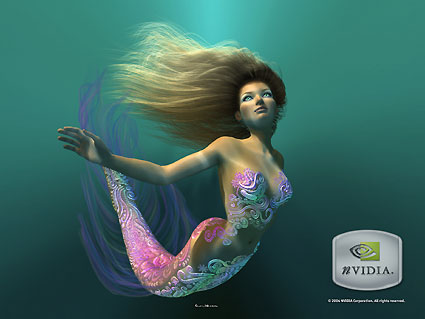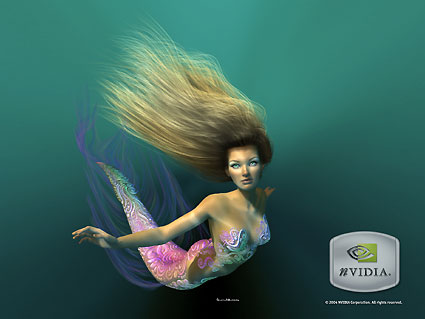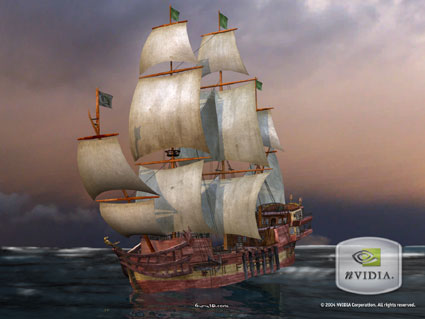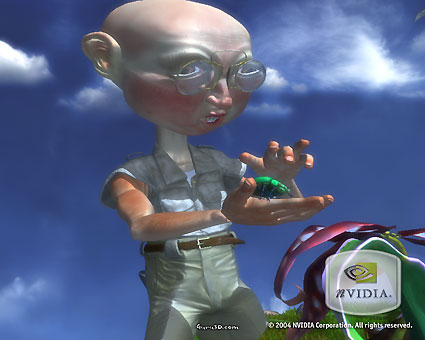Page 13 - Technology Demo's
As always with each new product there are new technology demo's. NVIDIA has an excellent tech demo team that I was honored to meet last year. This year's feast for the eyes is called Nalu. You already briefly met her, now have a look.
A small warning. You can click on the images to load up a high-res version. Some images are 1600x1200 pixels and half a meg in size ! Be sure to be on broadband connectivity when you decide to load it.
 Nalu [Hawaiin for wave], daughter of the deep sea, stops to admire a creature of the deep as it ascends towards the water's surface.
Nalu [Hawaiin for wave], daughter of the deep sea, stops to admire a creature of the deep as it ascends towards the water's surface.

NVIDIA GeForce 6800 GPUs render the soft shading of her long hair and the soft shadows on her skin.
Key Features:
1. Dense hair is simulated in real time and lit by a technique called "deep shadows" where the topmost hairs glow brightly from exposure to the light, while the lower hairs are darker.
2. Her skin is lit by the light refracted through the water's surface, her body and hair casting soft shadows on her as she swims.
3. Soft shafts of light filter down from the surface and are blocked by her silhouette using world-class, render-to-texture capabilities.
4. Her high-resolution skin transitions into a highly detailed scale shader that features the same soft shadowing as the skin, but adds a more noticeable bumpmap, iridescence and bio-luminescence.
5. The final render pass (19 in all) provides a soft glow that allows the bright light on her hair and skin to bloom on the screen.

NVIDIA Clear Sailing Technology Demo
The NVIDIA's new flagship is rendereing...erhm, yes a flagship :) Lot's of vertex and fragment shaders can create effects that were not possible before.
Key Features:
1. The ocean is adaptively tesselated and driven by both per-vertex waves and per-pixel waves.
2. The water surface is shaded by the environment with per-pixel Fresnel and refraction terms that include the ship itself.
3. Foam is computed dynamically in the vertex shader based on wave sharpness.
4. Splash is computed based on the physics of the boat and is driven by a particle simulation.
5. The ship is lit by the environment and shaded using colormaps, bumpmaps, real-time shadowmaps and a hemispherical occlusion term that describes its exposure to the environment.
6. Explosion, smoke and fire are present as the ship is destroyed.
Timbury Entonin Mudgett is a scientist who never lets entomology stand in the way of a good adventure. Forever searching for new and undiscovered specimens, he traverses jungles, prairies, and caves for rare insects.
Timbury stands apart in his dedication to extracting insect life from the most unusual places. In addition, his field sketches are legendary. He creates them in large numbers and the artistic license he takes in preparing them is quite singular. The vast majority of his insect drawings feature species previously unknown to science, and most are smiling so as to display their large shark-like teeth. Some of his depictions feature insects wearing shoes and clothes. Sadly, none of his actual specimens have lived up to the excitement generated by his drawings.
Many of his rarest finds, unfortunately, are more properly classified as bits of leaves and twigs. It is for this reason that Timbury is more often compared to that tireless promoter of the Piltdown Man hoax, Charles Dawson, instead of the inimitable Charles Darwin. Timbury, for his part, is just happy to contribute to the world's pool of information.
This odd man gives the NVIDIA GeForce 6800 GPUs an opportunity to show that they are not only vertex and pixel shading powerhouses, but that their native floating point precision allows them to handle 32-bit or 16-bit floating point data with ease.
Key Features:
1. Lighting is calculated in Industrial Light and Magic's OpenEXR 16-bit floating point math, enabling a high dynamic range not available on older graphics hardware. He is lit by the environment as opposed to artificial point lights, directional lights, or spotlights.
2. The scene is rendered into 16-bit floating point render target that allows the scene to be blurred, and is used to calculate the user's pupillary response. This causes the scene to lighten and darken based on how much light is hitting the eye. A post-processing step allows the bright areas to bloom into bright spots in the final image.
3. Timbury's facial features are refracted through his thick glasses to amplify his emotions as he inspects what he believes to be a prime specimen of the icky genus.
4. Subdivision surfaces provide a dynamic level of detail for Timbury based on the viewer's position.

